Copper vs Gold vs Oil - Why Copper Is the Tech Era’s New Inflation Hedge
2025-10-21 11:41:52
Why Copper Is Becoming the “New Oil” of the Tech Age

If gold guards wealth and oil fuels movement, copper connects it all. It’s the metal of energy, data, and transformation - the quiet backbone of modern progress. Every innovation that hums, charges, or computes runs through copper’s veins. It powers AI-driven data centers, wires electric vehicles, links renewable grids, and builds 5G networks. Without copper, the digital world would flicker and stall.
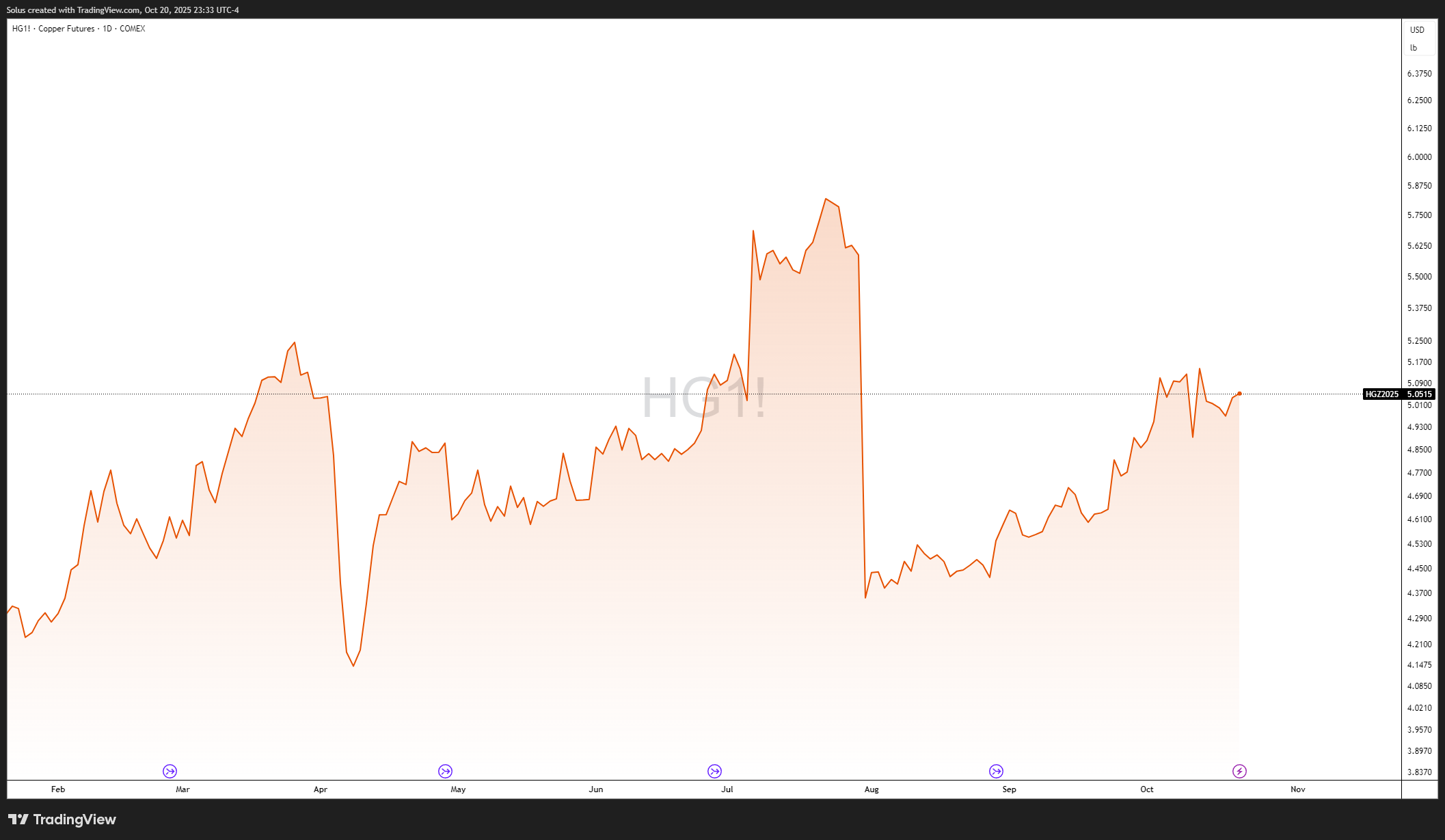
That’s why traders now call it “the new oil.” Not because it burns, but because it powers the 21st-century economy - a cleaner, smarter, electrified version of growth. When you understand how structure forms and confirms across timeframes, you’ll also see why copper tends to lead cyclical expansions; if you need a refresher on reading structure cleanly, revisit Multi-Timeframe Analysis in SMC and Price Action at Key Levels - those lenses apply beautifully to copper’s trend behavior.
Copper’s Identity: The Metal That Moves Economies
For decades, economists called copper “Dr. Copper” because it could “diagnose” economic health. When global growth strengthened, copper rose; when recessions loomed, it fell. But in the modern age, copper’s purpose has evolved - it’s no longer just the metal of construction but the metal of connection.
Every major global growth cycle - from the Industrial Revolution to today’s AI revolution - has copper at its heart. The difference now? Its demand is increasingly structural, not merely cyclical. If you follow intermarket context, this echoes the broader theme covered in Metals on the Rise and Commodities & Global Trade.
The Tech Era: Why AI and Electrification Need Copper
1. Copper and the AI Boom

AI has a physical footprint. Hyperscale data centers require massive power delivery, heat dissipation, and high-throughput local networking - all domains where copper’s conductivity and thermal performance shine. As models scale and GPUs proliferate, each square foot of compute pulls more current through copper-heavy infrastructure. That’s why copper often rallies alongside broader “risk-on” episodes tied to innovation; to read that signal cleanly in real time, pair your macro take with Risk-On/Risk-Off Sentiment.
2. EVs and Clean Energy

An EV uses roughly 3–4x the copper of an ICE car, and charging networks multiply that pull across cities. Solar, wind, storage, and the transmission that stitches it all together are copper-intensive. When expansion is policy-backed, copper demand becomes sticky - which is why aligning your trade plan with calendar catalysts (CPI, PMI, capex headlines) matters; see Inflation & Economic Data - Trader’s Guide for a clean playbook.
3. Digital Infrastructure and 5G

From last-mile broadband to tower-to-core interconnects, copper still does heavy lifting. The smarter the grid and the denser the compute, the more copper we quietly consume to keep latency low and efficiency high.
Copper, Gold, and Oil: The Trio of Economic Truths
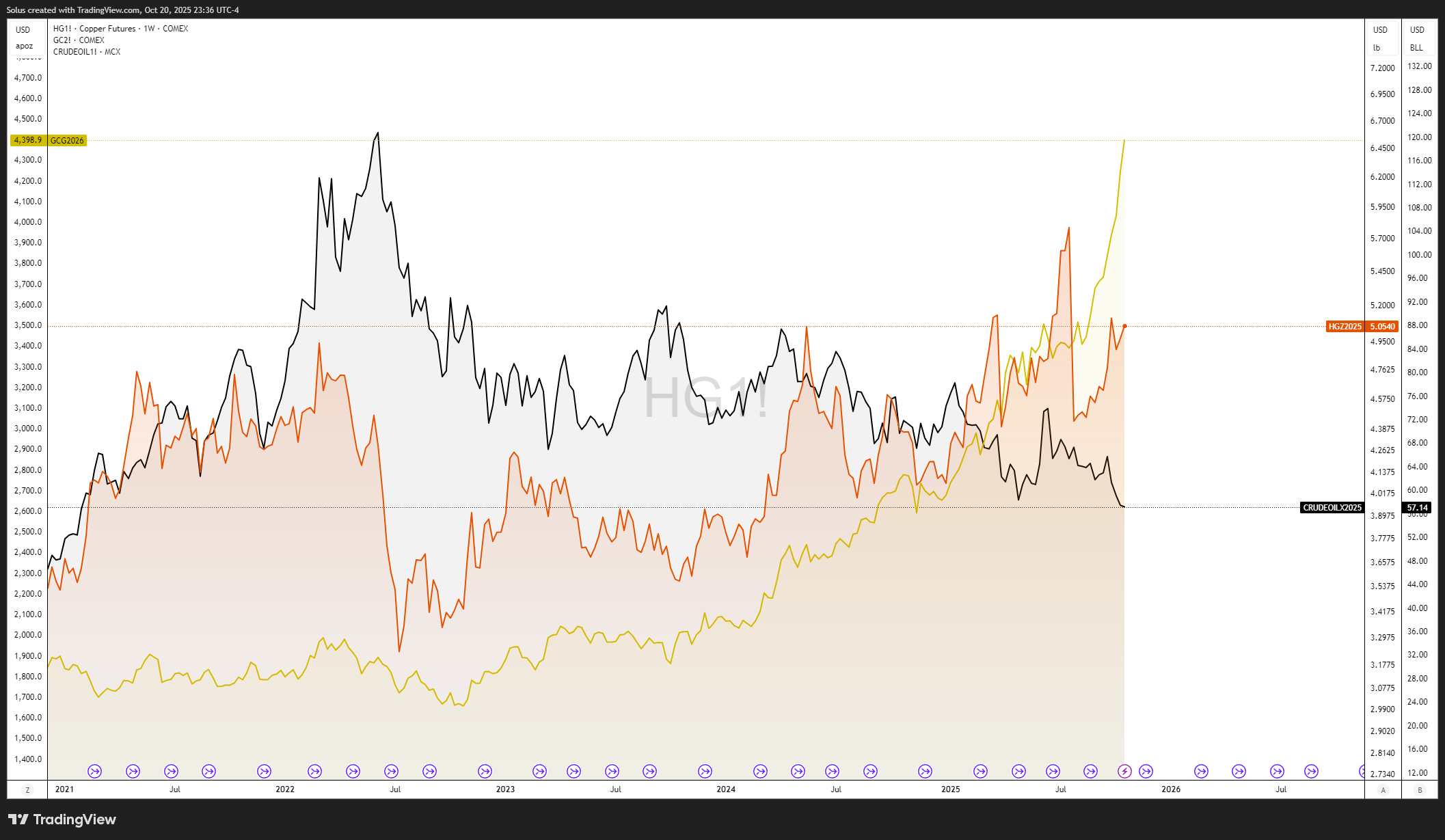
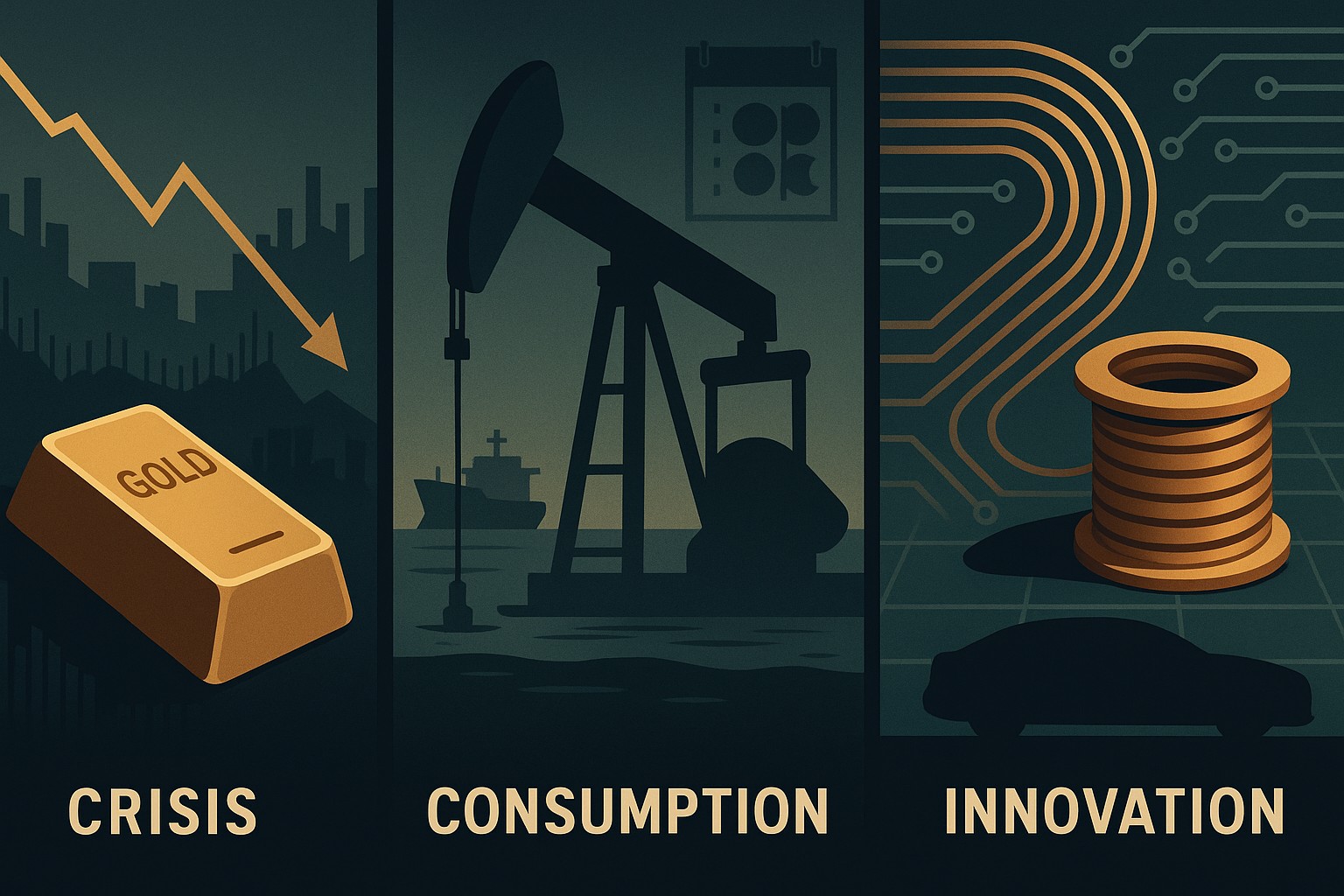
| Asset | Symbolism | What Drives It | Type of Hedge | Economic Cycle |
|---|---|---|---|---|
| Gold | Wealth Preservation | Uncertainty, real yields | Crisis Hedge | Risk-Off / Recession |
| Oil | Energy & Mobility | Consumption, OPEC/geopolitics | Consumption Hedge | Expansion / Energy Boom |
| Copper | Growth & Technology | Industrial activity, electrification, AI capex | Innovation Hedge | Structural Growth / Transition |
- Gold protects when fear dominates.
- Oil surges when mobility and consumption spike.
- Copper thrives when the world rebuilds, rewires, and digitizes - the connective tissue of progress.
If you enjoy mapping these relationships into actionable trades, fold them into your correlation grid as outlined in Intermarket Analysis for Traders.
Why Copper’s Supply Can’t Keep Up
Ore grades are declining, new mines face long permitting cycles, and key producers juggle political and environmental constraints. Demand, driven by AI, EVs, and grid upgrades, compounds annually. That’s the recipe for a structural deficit: slow supply, fast technology. The medium-term implication is straightforward - trends can persist longer than most traders expect, rewarding those who scale with confirmation rather than chase noise.
Copper and Inflation: The Modern Growth Hedge
Classic inflation hedges like gold reflect fear and falling real yields. Copper reflects productive inflation - the kind born from capex, construction, and digital electrification. When cost-push (energy/mining) meets demand-pull (AI/EVs/grids), copper becomes the asset that captures expansion itself. That framing mirrors the broader metals narrative you’ve seen in Gold vs Silver: Institutional Demand - different metals, different hedges, different phases of the cycle.
How to Trade Copper: Market Structure Meets Macro Story
1. Map the range on H4/D1; mark external highs/lows and key zones.
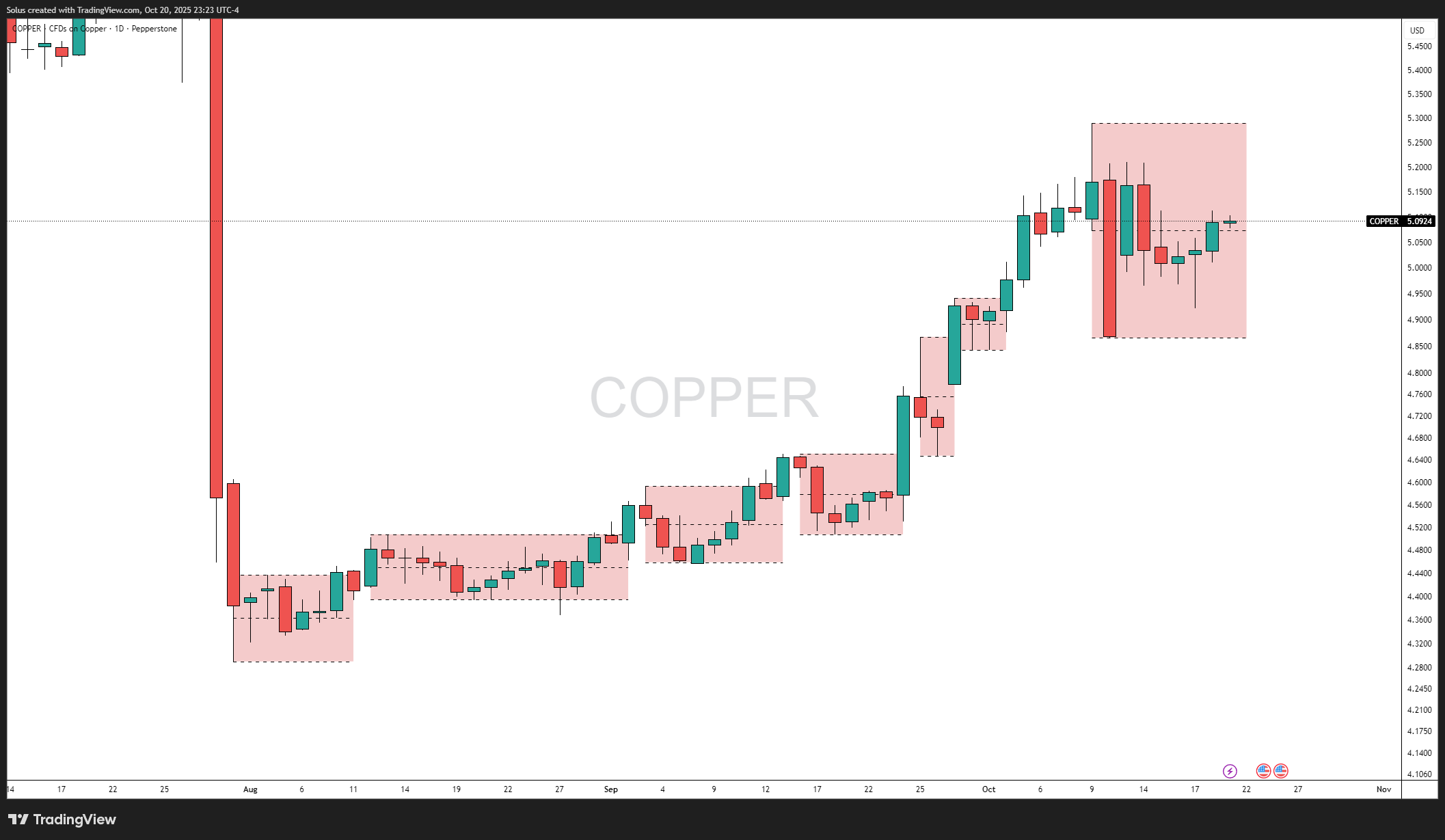
2. Wait for displacement: a decisive break with volume that leaves Fair Value Gaps (review FVGs Explained to keep entries consistent).
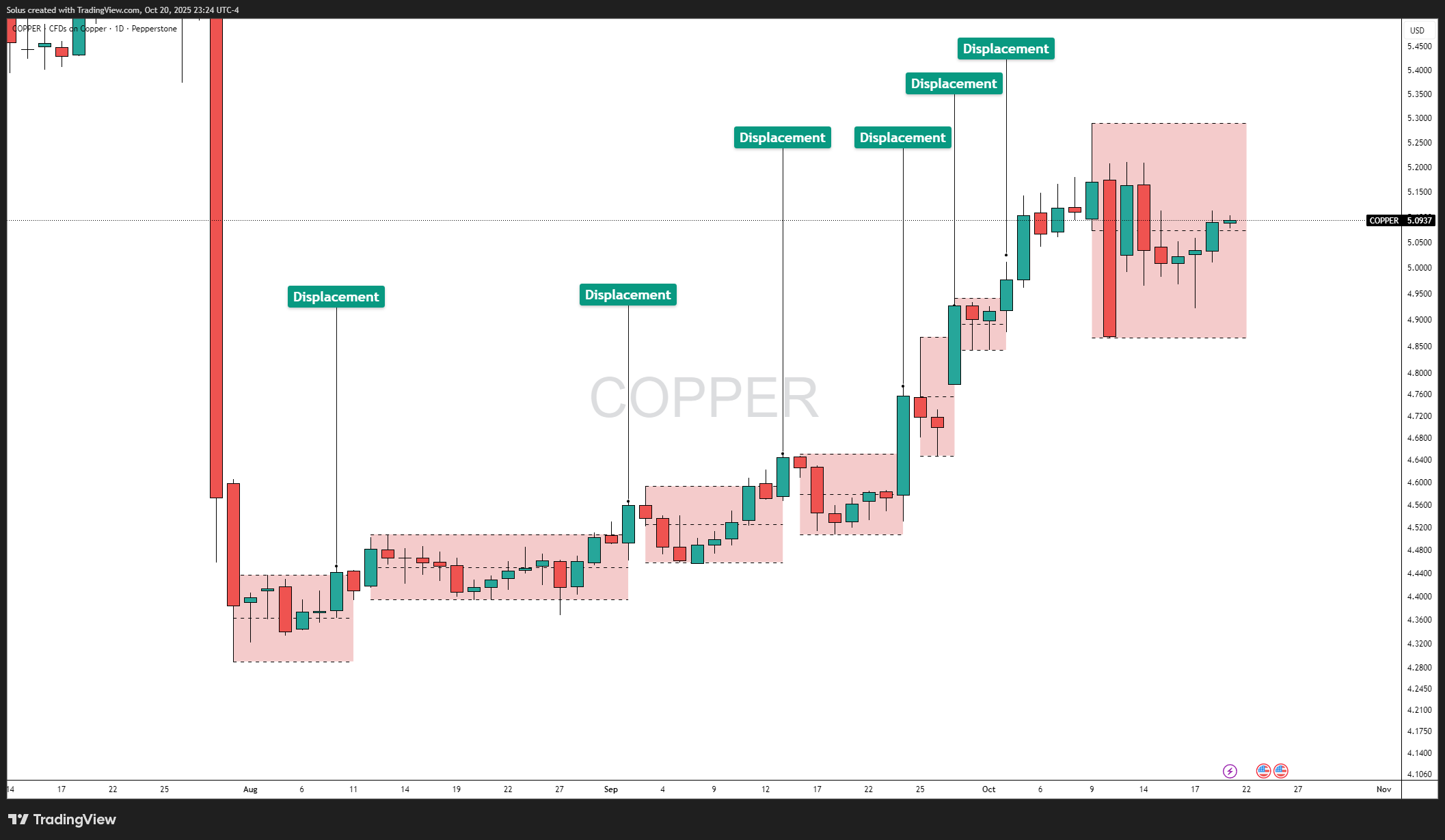
3. Time with catalysts: China PMI, U.S. infrastructure headlines, or AI/semiconductor capex news.
4. Enter on confirmation: a sweep/reclaim + structure shift is superior to mid-range impulses; if you like this logic, the Liquidity Sweep Playbook keeps you disciplined.
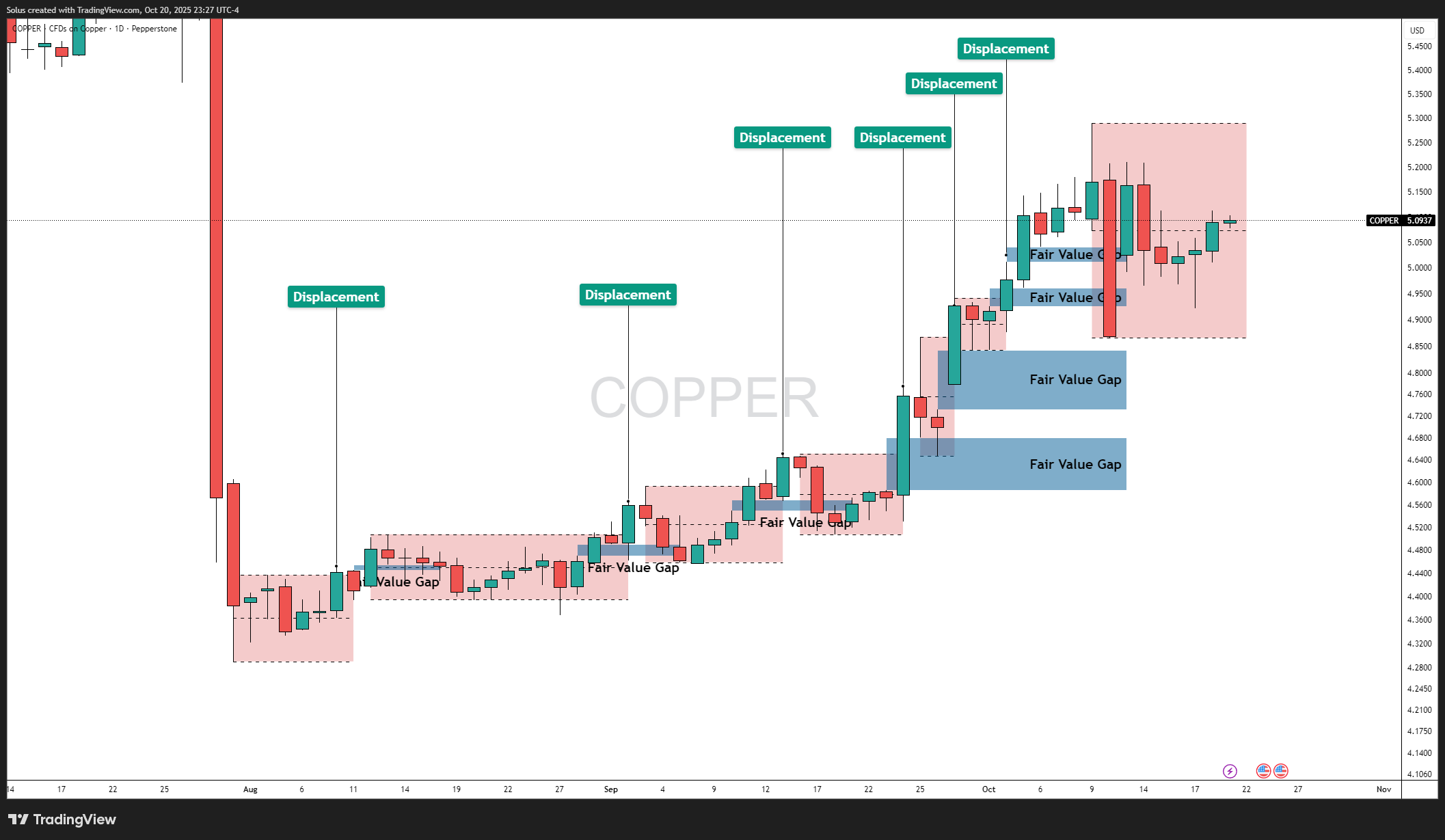
Entry Points:
- Range Breakout + Discplacement Candle
- Pullback + Limit Order at FVG
Real-Life Analogy: Copper Is the Nervous System of the Modern World
Think of gold as the brain (store of value), oil as the muscle (kinetic energy), and copper as the nervous system - transmitting signals and power everywhere at once. No copper, no current. No current, no compute. Every AI inference, EV mile, and watt of wind power flows through copper’s pathways.
Final Thoughts

Copper is no longer just another cyclical metal; it’s the infrastructure of innovation. Gold will keep guarding capital in fear, and oil will keep moving the real economy. But copper is the metal that makes the future work - from server racks to city grids. If your playbook already tracks structure, liquidity, and correlations, you’re one small step from turning copper’s macro narrative into a durable trading edge.
FAQs
1. Why is copper in such high demand now?
Because AI data centers, EVs, renewables, and grid upgrades all require copper’s unmatched conductivity and thermal performance; as those ecosystems scale, copper usage scales with them.
2. How does copper differ from gold and oil as a hedge?
Gold hedges fear, oil hedges consumption, copper hedges innovation-led growth - three assets for three very different macro regimes.
3. Is copper’s rally sustainable?
The supply pipeline is slow, while tech-driven demand compounds. That asymmetry supports a multi-year bullish bias with healthy retracements.
4. How can retail traders gain exposure?
Through copper futures, miners, or ETFs - and by executing with structure (FVGs, sweeps, displacement) rather than chasing vertical moves.
Start Practicing with Confidence - Risk-Free!
- Trade forex, indices, gold, and more
- Access ACY, MT4, MT5, & Copy Trading Platforms
- Practice with zero risk
It’s time to go from theory to execution - risk-free.
Create an Account. Start Your Free Demo!
Check Out My Contents:
Strategies That You Can Use
Looking for step-by-step approaches you can plug straight into the charts? Start here:
- How To Trade & Scalp Indices at the Open Using Smart Money Concepts (SMC)
- How to Trade Breakouts Effectively in Day Trading with Smart Money Concepts
- Complete Step-by-Step Guide to Day Trading Gold (XAU/USD) with Smart Money Concepts (SMC)
- The Power of Multi-Timeframe Analysis in Smart Money Concepts (SMC)
- Forex Trading Strategy for Beginners
- Mastering Candlestick Pattern Analysis with the SMC Strategy for Day Trading
- How to Use Fibonacci to Set Targets & Stops (Complete Guide)
- RSI Divergence Trading Strategy for Gold: How to Identify and Trade Trend Reversals
- Stochastics Trading Secrets: How to Time Entries in Trending Markets using Stochastics
- Gold Trading Stochastics Strategy: How to Trade Gold with 2R - 3R Targets
- RSI Hidden Divergence Explained: How to Spot Trend Continuations Like a Pro
- Moving Averages Trading Strategy Playbook
- Mastering Fibonacci Trading Psychology - Trusting the Levels, Managing the Mind
- Mastering Price Action at Key Levels - How to Spot, Trade, and Win at the Most Crucial Zones
- Mastering Retests: How to Enter with Confirmation After a Breakout
Indicators / Tools for Trading
Sharpen your edge with proven tools and frameworks:
- The Ultimate Guide to Risk Management in Trading - A Complete Compilation for 2025
- Moving Averages Trading Strategy Playbook
- How to Think Like a Price Action Trader
- Mastering Fibonacci Trading Psychology - Trusting the Levels, Managing the Mind
How To Trade News
News moves markets fast. Learn how to keep pace with SMC-based playbooks:
- Why Smart Money Concepts Work in News-Driven Markets - CPI, NFP, and More
- How to Trade NFP Using Smart Money Concepts (SMC) - A Proven Strategy for Forex Traders
- How to Trade CPI Like Smart Money - A Step-by-Step Guide Using SMC
Learn How to Trade US Indices
From NASDAQ opens to DAX trends, here’s how to approach indices like a pro:
- How to Start Trading Indices and Get into the Stock Market with Low Capital (2025 Guide)
- Best Indices to Trade for Day Traders | NASDAQ, S&P 500, DAX + Best Times to Trade Them
- How To Trade & Scalp Indices at the Open Using Smart Money Concepts (SMC)
- NAS100 - How to Trade the Nasdaq Like a Pro (Smart Money Edition)
How to Start Trading Gold
Gold remains one of the most traded assets - here’s how to approach it with confidence:
- How to Swing Trade Gold (XAU/USD) Using Smart Money Concepts: A Simple Guide for Traders
- Complete Step-by-Step Guide to Day Trading Gold (XAU/USD) with Smart Money Concepts (SMC)
- The Ultimate Guide to Backtesting and Trading Gold (XAU/USD) Using Smart Money Concepts (SMC)
- Why Gold Remains the Ultimate Security in a Shifting World
- How to Exit & Take Profits in Trading Gold Like a Pro: Using RSI, Range Breakdowns, and MAs as Your Confluence
How to Trade Japanese Candlesticks
Candlesticks are the building blocks of price action. Master the most powerful ones:
- Mastering the Top Japanese Candlesticks: The Top 5 Candlesticks To Trade + Top SMC Candlestick Pattern
- How to Trade Candlestick Patterns with High Probability: A Complete Guide for Beginners
- The Top Japanese Candlestick Guide: What is an Engulfing Pattern and How to Trade It?
- Piercing Pattern Candlestick Explained: How to Trade It - Step-By-Step Guide
- Morning & Evening Star Candlestick Patterns - How to Trade Market Reversals with Confidence
How to Start Day Trading
Ready to go intraday? Here’s how to build consistency step by step:
- 5 Steps to Start Day Trading: A Strategic Guide for Beginners
- 8 Steps How to Start Forex Day Trading in 2025: A Beginner’s Step-by-Step Guide
- 3 Steps to Build a Trading Routine for Consistency and Discipline - Day Trading Edition
- The Ultimate Guide to Understanding Market Trends and Price Action
- Trading with Momentum: The Best Trading Session to Trade Forex, Gold and Indices
Swing Trading 101
- Introduction to Swing Trading
- The Market Basics for Swing Trading
- Core Principles of Swing Trading
- The Technical Foundations Every Swing Trader Must Master
- Swing Trader’s Toolkit: Multi-Timeframe & Institutional Confluence
- The Psychology of Risk Management in Swing Trading
- Swing Trading Concepts To Know In Trading with Smart Money Concepts
- Becoming a Consistent Swing Trader: Trading Structure & Scaling Strategy
Learn how to navigate yourself in times of turmoil
Markets swing between calm and chaos. Learn to read risk-on vs risk-off like a pro:
- How to Identify Risk-On and Risk-Off Market Sentiment: A Complete Trader’s Guide
- How to Trade Risk-On and Risk-Off Sentiment - With Technical Confirmation
- The Ultimate Guide to Understanding Market Trends and Price Action
Want to learn how to trade like the Smart Money?
Step inside the playbook of institutional traders with SMC concepts explained:
- Why Smart Money Concepts Work: The Truth Behind Liquidity and Price Action
- Mastering the Market with Smart Money Concepts: 5 Strategic Approaches
- Understanding Liquidity Sweep: How Smart Money Trades Liquidity Zones in Forex, Gold, US Indices
- The SMC Playbook Series Part 1: What Moves the Markets? Key Drivers Behind Forex, Gold & Stock Indices
- The SMC Playbook Series Part 2: How to Spot Liquidity Pools in Trading - Internal vs External Liquidity Explained
- Fair Value Gaps Explained: How Smart Money Leaves Footprints in the Market
- Accumulation, Manipulation, Distribution: The Hidden Cycle That Runs Every Market
- Institutional Order Flow - Reading the Market Through the Eyes of the Big Players
- London Session Trading Secrets: How Smart Money Sets the High & Low of the Day
- Mastering the New York Session - Smart Money Concepts Guide
Master the World’s Most Popular Forex Pairs
Forex pairs aren’t created equal - some are stable, some are volatile, others tied to commodities or sessions.
- The Top 5 All-Time Best Forex Pairs to Trade
- Top Forex Pairs Beyond the Big Five
- EUR/USD: The King of Forex
- USD/JPY: The Fast Mover
- GBP/USD: The Volatile Cable
- AUD/USD: The Commodity Currency
- USD/CAD: The Oil-Backed Pair
- GBP/JPY: How to Trade The Beast
- Asian & London Session Secrets
- Mastering the New York Session
Metals Trading
- Metals Trading: Why Gold and Metals Are Rising Again
- Silver Trading: The Underdog with Dual Identity
- Gold vs Silver: Institutional Demand Breakdown Explained
Stop Hunting 101
If you’ve ever been stopped out right before the market reverses - this is why:
- Stop Hunting 101: How Swing Highs and Lows Become Liquidity Traps
- Outsmarting Stop Hunts: The Psychology Behind the Trap
- How to Lessen Risk From Stop Hunts in Trading
- How Stop Hunts Trigger Revenge Trading - Breaking the Pain Cycle
- How to Accept Stop Hunts Without Losing Discipline - Shifting From Frustration to Focus
Trading Psychology
Mindset is the deciding factor between growth and blowups. Explore these essentials:
- The Mental Game of Execution - Debunking the Common Trading Psychology
- Managing Trading Losses: Why You Can Be Wrong and Still Win Big in Trading
- The Hidden Threat in Trading: How Performance Anxiety Sabotages Your Edge
- Why 90% of Retail Traders Fail Even with Profitable Trading Strategies
- Top 10 Habits Profitable Traders Follow Daily to Stay Consistent
- Top 10 Trading Rules of the Most Successful Traders
- Top 10 Ways to Prevent Emotional Trading and Stay Disciplined in the Markets
- Why Most Traders Fail - Trading Psychology & The Hidden Mental Game
- Emotional Awareness in Trading - Naming Your Triggers
- Discipline vs. Impulse in Trading - Step-by Step Guide How to Build Control
- Trading Journal & Reflection - The Trader’s Mirror
- Overcoming FOMO & Revenge Trading in Forex - Why Patience Pays
- Risk of Ruin in Trading - Respect the Math of Survival
- Identity-Based Trading: Become Your Trading System for Consistency
- Trading Psychology: Aligning Emotions with Your System
- Mastering Fear in Trading: Turn Doubt into a Protective Signal
- Mastering Greed in Trading: Turn Ambition into Controlled Growth
- Mastering Boredom in Trading: From Restless Clicking to Patient Precision
- Mastering Doubt in Trading: Building Confidence Through Backtesting and Pattern Recognition
- Mastering Impatience in Trading: Turn Patience Into Profit
- Mastering Frustration in Trading: Turning Losses Into Lessons
- Mastering Hope in Trading: Replacing Denial With Discipline
- When to Quit on Trading - Read This!
- The Math of Compounding in Trading
- Why Daily Wins Matter More Than Big Wins
- Scaling in Trading: When & How to Increase Lot Sizes
- Why Patience in Trading Fuels the Compounding Growth
- Step-by-Step Guide on How to Manage Losses for Compounding Growth
- The Daily Habits of Profitable Traders: Building Your Compounding Routine
- Trading Edge: Definition, Misconceptions & Casino Analogy
- Finding Your Edge: From Chaos to Clarity
- Proving Your Edge: Backtesting Without Bias
- Forward Testing in Trading: How to Prove Your Edge Live
- Measuring Your Edge: Metrics That Matter
- Refining Your Edge: Iteration Without Overfitting
- The EDGE Framework: Knowing When and How to Evolve as a Trader
- Scaling Your Edge: From Small Account to Consistency
Market Drivers
- Central Banks and Interest Rates: How They Move Your Trades
- Inflation & Economic Data: CPI Trading Strategy and PPI Indicator Guide
- Geopolitical Risks & Safe Havens in Trading (Gold, USD, JPY, CHF)
- Jobs, Growth & Recession Fears: NFP, GDP & Unemployment in Trading
- Commodities & Global Trade: Oil, Gold, and Forex Explained
- Market Correlations & Intermarket Analysis for Traders
Risk Management
The real edge in trading isn’t strategy - it’s how you protect your capital:
- Mastering Risk Management: Stop Loss, Take Profit, and Position Sizing
- Why Risk Management Is the Only Edge That Lasts
- How Much Should You Risk per Trade? (1%, 2%, or Less?)
- The Ultimate Risk Management Plan for Prop Firm Traders - Updated 2025
- Mastering Position Sizing: Automate or Calculate Your Risk Like a Pro
- Martingale Strategy in Trading: Compounding Power or Double-Edged Sword?
- How to Add to Winners Using Cost Averaging and Martingale Principle with Price Confirmation
Suggested Learning Path
If you’re not sure where to start, follow this roadmap:
- Start with Trading Psychology → Build the mindset first.
- Move into Risk Management → Learn how to protect capital.
- Explore Strategies & Tools → Candlesticks, Fibonacci, MAs, Indicators.
- Apply to Assets → Gold, Indices, Forex sessions.
- Advance to Smart Money Concepts (SMC) → Learn how institutions trade.
- Specialize → Stop Hunts, News Trading, Turmoil Navigation.
This way, you’ll grow from foundation → application → mastery, instead of jumping around randomly.
Follow me for more daily market insights!
Jasper Osita - LinkedIn - FXStreet - YouTube
This content may have been written by a third party. ACY makes no representation or warranty and assumes no liability as to the accuracy or completeness of the information provided, nor any loss arising from any investment based on a recommendation, forecast or other information supplies by any third-party. This content is information only, and does not constitute financial, investment or other advice on which you can rely.
Try These Next
4 Powerful Tactics to Overcome the Most Costly Forex Mistakes
How to Master MT4 & MT5 - Tips and Tricks for Traders
The Importance of Fundamental Analysis in Forex Trading
Forex Leverage Explained: Mastering Forex Leverage in Trading & Controlling Margin
The Importance of Liquidity in Forex: A Beginner's Guide
Close All Metatrader Script: Maximise Your Trading Efficiency and Reduce Stress
Best Currency Pairs To Trade in 2025
Forex Trading Hours: Finding the Best Times to Trade FX
MetaTrader Expert Advisor - The Benefits of Algorithmic Trading and Forex EAs
Top 5 Candlestick Trading Formations Every Trader Must Know















